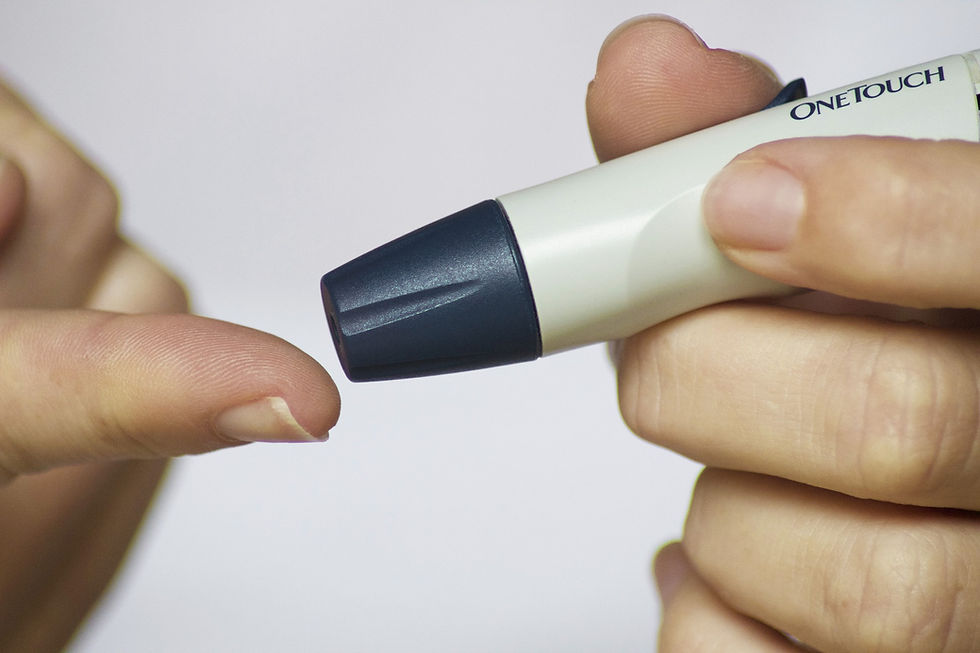Let’s Talk About Glucose.
- May 5
- 4 min read

It’s another hot topic in the wellness business at the moment, with glucose trackers popping up across social media and being advertised as the latest tool to ‘control’ your hunger and eating.
If you’re a regular reader you probably have some inclination as to how we at Elevate feel about that.
But let’s start off simple – what exactly IS glucose, and why is it so important?
Glucose plays a central role in our bodies, it’s not just a form of sugar in the blood, but the body’s primary fuel source. Every time we eat foods that contain carbohydrates, whether that’s fruit, vegetables, whole grains, or legumes, the body breaks those down into glucose, which is then used by our cells to produce energy.
This is especially important for our wonderful brains, which rely almost exclusively on glucose to function well (so, yeh, it’s a biggie). While the body can use fat and protein in certain circumstances, glucose is by far the most efficient and preferred source of energy, particularly for high-intensity physical activity and cognitive performance (both of which we value).
But, of course, much like fat in the 1990s and carbs in the early 2000s, we’re now seeing early signs that glucose itself is being vilified. It’s the dreaded sugar word (rolls eyes).
To be clear. It is NORMAL to have a rise in blood glucose after eating a balanced meal. It’s even completely normal to have occasional high spikes.
Yet, we’re seeing this normal bodily process being framed as something to worry about (honestly, we’re not over here looking for more things to worry about, amiright?).
And this shift is being driven, in large part, by the rise of consumer glucose trackers and the marketing messages that come with them. Continuous glucose monitors (CGMs), which were originally designed for people with diabetes, are now being sold to perfectly healthy individuals as tools to ‘optimise’ their diet, energy, and metabolism.
Now, don’t get me wrong. There’s no doubt that CGMs can be useful in clinical settings. For people with diabetes or insulin resistance, being able to see real-time glucose data can help with medication adjustments, meal planning, and avoiding dangerous blood sugar highs or lows.
However, their widespread promotion to the general population, particularly through social media and wellness influencers raises important questions. What are people actually learning from these devices, and are the benefits worth the potential downsides?
And let’s not forget to ask, who is actually benefitting from us buying one?
So, the pros.
Supporters argue that glucose tracking allows for greater dietary awareness and personalisation. Since individuals can respond differently to the same foods, CGMs can offer insight into how specific meals affect each person’s blood sugar, helping to reduce post-meal crashes or energy dips.
Some users report that wearing a monitor motivates them to make healthier choices, eat more fibre, or time their meals better around physical activity. For those who are very data-driven, a CGM can feel empowering and educational (at least in the short term – we’ll come back to this).
Yet, the cons.
As mentioned above, glucose fluctuations are a completely normal and healthy part of human physiology. Our bodies are designed to handle rises in blood sugar after eating. But, when people see these rises and interpret them as something to be “fixed” or “flattened,” (as CGM followers often seem to imply) we can start to fear foods that are actually super nutritious - like fruit, oats, or legumes - simply because they cause a temporary increase in glucose.
It’s this kind of fear-based response that is a concern, and can lead to disordered eating, excessive food restriction, or the belief that the body is somehow broken unless glucose is tightly controlled at all times.
Another concern is the subtle messaging around ‘low glucose’ as a health goal.
While it may sound virtuous, low glucose is not something to strive for. In fact, consistently low levels can be harmful, especially if they interfere with brain function, physical performance, or hormonal balance.
The narrative that flatter glucose curves equal better health is not supported by long-term evidence, particularly in people who are already metabolically healthy. In many cases, CGMs provide a false sense of precision and urgency, encouraging people to optimise data points that don’t actually reflect meaningful improvements in wellbeing.
So, what are we saying here?
Well, if you have a family history of diabetes or are concerned about your glucose levels for valid health reasons, then a glucose monitor could be a great way of easing your mind and collecting info about your body. But for the average person? Honestly, it’s unlikely to provide and life changing revelations.
Like so many other new products on the market offering a ‘quick fix’ to health and wellness, CGMs don’t and can’t replace eating mindfully, being aware of your body, and regular exercise. It feels like sometimes we bang on about how the most you can do for yourself are all the age-old, somewhat boring, un-glamorous things – eating mostly whole, unprocessed foods, moving regularly, managing stress, sleeping well, and not skipping meals. We chat about this a lot for a reason – it works (and is demonstrated to have positive impacts by an absolute wealth of scientific research).
So just remember - glucose is not the enemy. It’s a critical part of how our bodies function. The goal isn’t to eliminate every spike, but to support metabolic health through sustainable, evidence-based habits.
And, as with any new wellness trend, it’s worth asking; is this tool helping people feel better and make meaningful changes, or is it just another high-priced gadget wrapped in fear and optimisation culture?
-Ali Curzon
Nutrition Coach


Comments